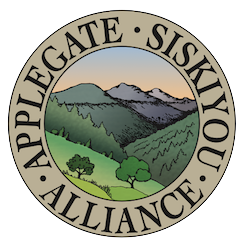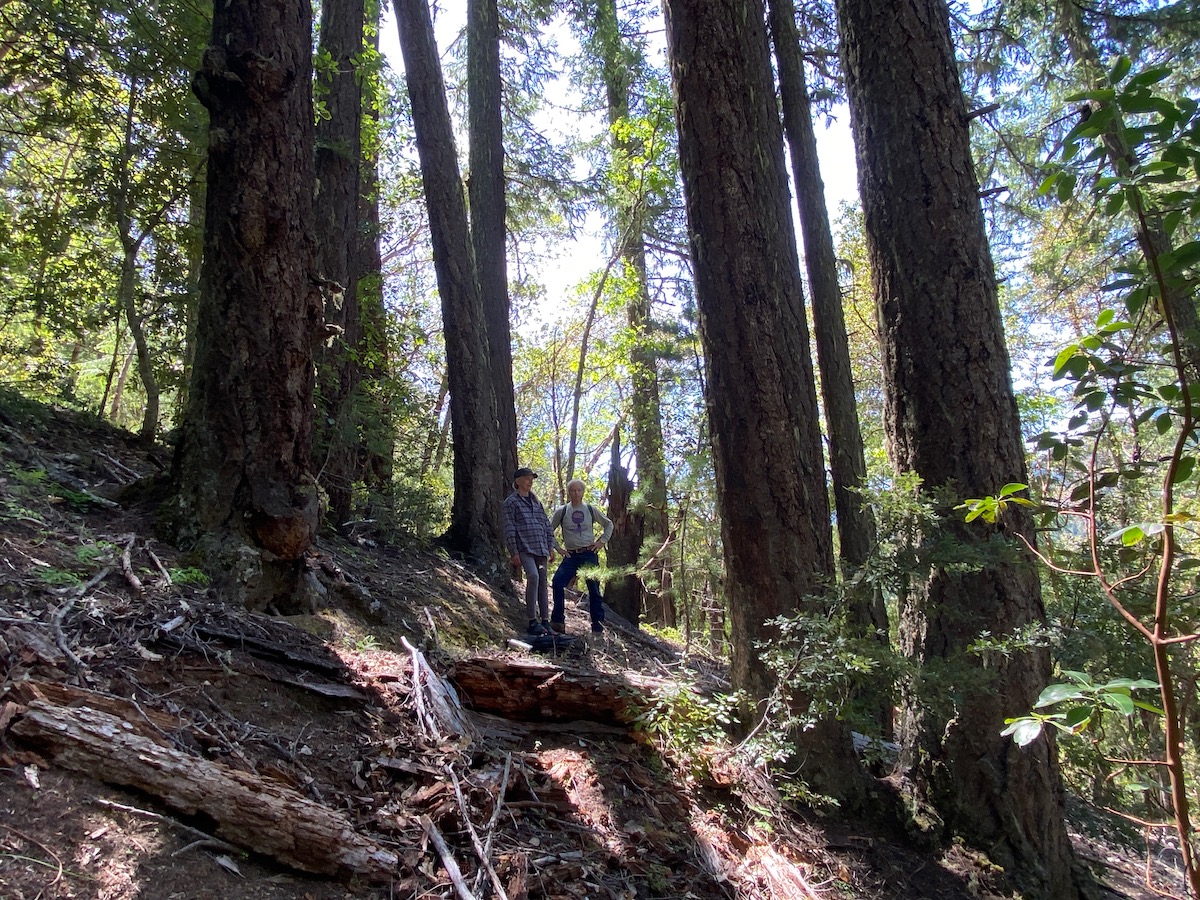The IVM Project is a massive, landscape-scale logging proposal recently approved by the Medford District BLM in southwestern Oregon. The IVM Project would allow for the implementation of up to 20,000 acres of commercial logging and 90 miles of new road construction in the next ten years, with virtually no site-specific environmental analysis, scientific review or public input. It would also specifically target Late Successional Reserve (LSR) forests set aside to protect habitat for the northern spotted owl and other species dependent on mature or old-growth forests.

These mature and old-growth forests are increasingly rare and increasingly important for the habitat they provide, the carbon they store, and the watershed values they protect. They are also increasingly threatened as the Medford District BLM proposes to implement the IVM Project.
Unfortunately, the BLM has proposed to begin implementation of the IVM Project with the Penn Butte and Late Mungers Timber Sales in the mountains between Murphy and Williams, Oregon. These timber sales are located, at least partially, in the rain forests of the Applegate, on Mungers Creek and upper Powell Creek. On the western margin of the Applegate River watershed, these drainages receive abundant rainfall, and dense coastal fog often pours over the ridgeline from the Illinois Valley in the winter months. This fog and rain tends to settle in these forested canyons, sustaining lush habitats indicative of the Pacific Northwest, but with a Siskiyou Mountain flare.
Forests of the endemic and threatened Port Orford-cedar grow in upper Williams Creek, along with productive forests of Douglas fir and tanoak. These habitats support plant communities not commonly found in the dry forests of the Applegate Valley, including a coastal understory shrub association of evergreen huckleberry, red huckleberry, salal, and vine maple.

Yet the BLM portions of Mungers Creek and upper Powell Creek are not just lush, carbon-rich forests; together, these drainages also contain one of the largest blocks of old forest remaining in the Mungers LSR. This large, relatively intact block of moist forest habitat is particularly important for the northern spotted owl, the Pacific fisher, the Humboldt marten and other wildlife species. Unfortunately, this same area contains a significant concentration of commercial logging units in the Penn Butte Timber Sale.
Recently, we have been out monitoring these timber sale units and below is what we found.
Units covered in this post

Unit 25-1A
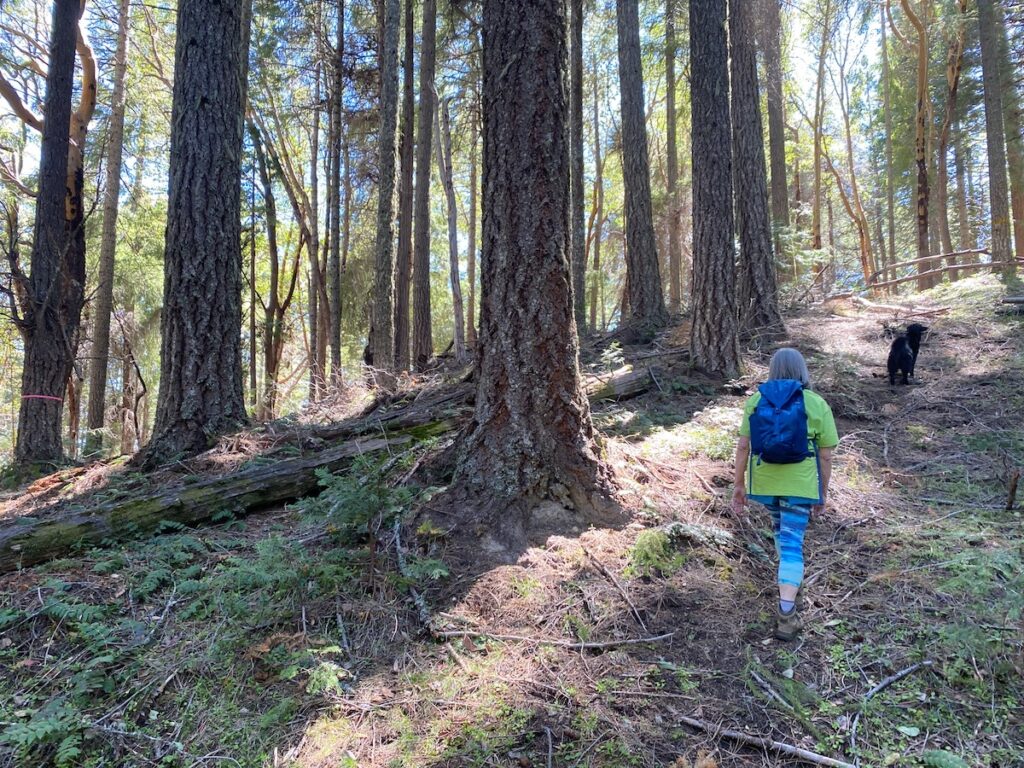
Unit 25-1A is part of a beautiful and highly diversified forest straddling the ridgeline between Mungers and Powell Creek, at the heart of the Mungers LSR. The unit spills over the ridge into both watersheds and contains mature and late successional forest habitat proposed for logging “treatments” that would fragment forest canopy and remove large, fire resistant trees throughout this spectacular stand.
The south-facing slopes support relatively dry forest associations of pine, fir, incense cedar and madrone, draining into the North Fork Mungers Creek. The north-facing slopes on the other hand, contain more mesic conditions. These north-facing forests contain beautiful groves of Douglas fir, incense cedar, tanoak and madrone, with thickets of young Port Orford-cedar in slight topographical depressions. This stand contains a much higher percentage of large incense cedar than other units in the Penn Butte Timber Sale and represents a forest association that is relatively unique in the planning area.
Although not identified as such on BLM maps, these forests also contain all the necessary characteristics for northern spotted owl nesting habitat and should be withdrawn from commercial entry in the Penn Butte Timber Sale. Additionally, the south-facing slopes and the remainder of unit 25-1 contain important connectivity habitat and unidentified nesting habitat. These stands tie together high quality blocks of northern spotted owl habitat in both upper Mungers and upper Powell Creek.

Logging treatments in unit 25-1A and across the larger landscape will fragment habitat connectivity, reduce suitable habitat available for the northern spotted owl and other wildlife species and degrade the old forest values remaining in the Mungers LSR, in both the long and short term.
Although unit 25-1A contains spectacularly beautiful forest habitats, the unit is also proposed for some of the heaviest logging prescriptions authorized under the IVM Project. Ironically, called “ecosystem resilience-open” prescriptions, these treatments allow significant canopy removal down to as low as 30%. Due to the heavy prescription proposed and the old forest targeted for logging, this unit likely contains the largest concentration of trees over 30” diameter proposed for removal in the entire Penn Butte Timber Sale, and the treatments proposed are inconsistent with both species recovery for the northern spotted owl and the mandates of the BLM’s 2016 Resource Management Plan (RMP), which promotes the development of additional northern spotted owl habitat in the LSR forest network.

The old trees in unit 25-1A are either relatively open grown or grow in complex clumps or groupings of older, more dominant trees. Neither these groupings or individual dominant trees should not be altered by industrial logging, as they currently provide the most important late successional forest characteristics within this beautiful stand.
Healthy groves of hardwoods such as madrone and some tanoak form a secondary canopy, clumps of young Port Orford-cedar also add to the structural diversity and canopy layering, while scattered old snags are distributed throughout the stand, and large downed wood lies strewn across the forest floor, creating diversity, holding moisture and providing structural complexity.
Unit 25-1A needs no “treatment” to maintain its health, the area is not unnaturally dense, and the area does not sustain a heavy fuel load; however, these productive old forests contain abundant standing timber volume and BLM intends to convert large portions of this old forest into lumber for local mills. This would be done at the expense of old forest values, fire resilience, wildlife habitat, the area’s spectacular scenic qualities, and nearby local communities.
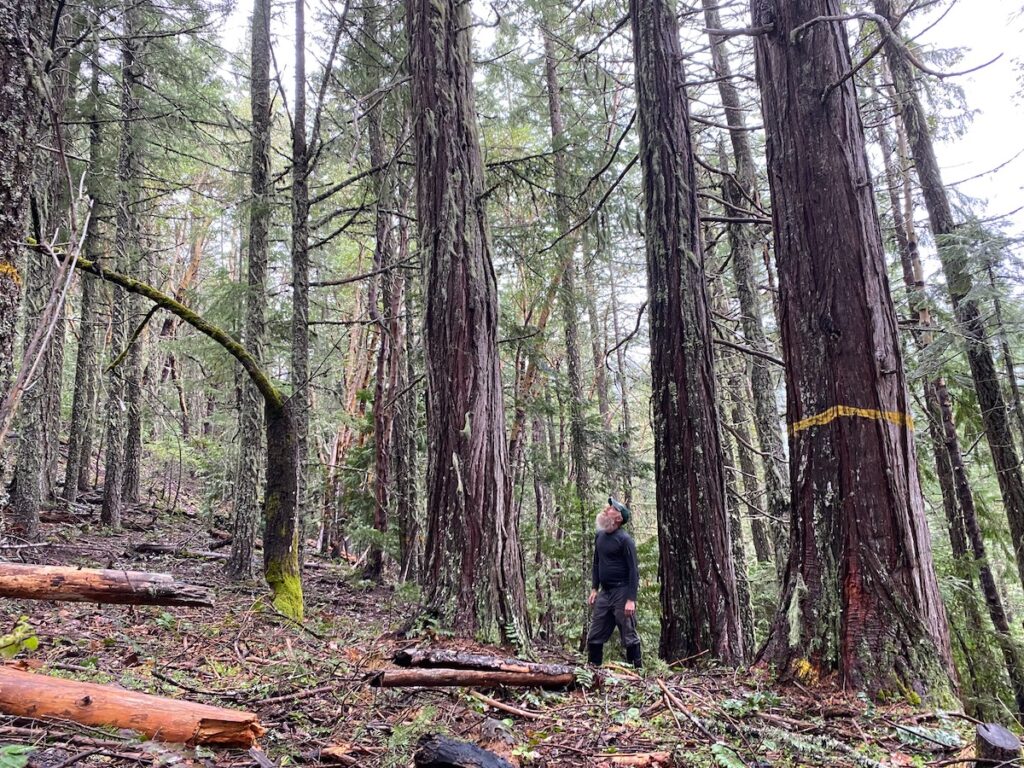
Unit 25-1A demonstrates everything that is wrong with the Penn Butte Timber Sale. This unit, along with the entire Penn Butte Timber Sale, should be withdrawn and the area’s old forests should be maintained for the purposes the Mungers LSR was designated for, namely, the protection, not the destruction of old forest habitat.
Unit 25-1B

Directly below unit 25-1A and directly below road 38-5-15, unit 25-1B is located on a south-facing slope at the headwaters of North Fork Mungers Creek. This stand contains relatively productive forests of Douglas fir, ponderosa pine, sugar pine, incense cedar and madrone. Old, dominant trees grow in natural groupings or as individual trees scattered throughout the stand with a younger, but mature cohort of fir, cedar and madrone filling in canopy space.
Like other units we have visited, unit 25-1B was previously thinned in the Deer Willy Stewardship Project, which focused on small diameter tree removal and non-commercial fuel reduction treatments. According to the analysis that led to this project, the treatments were focused on maintaining large trees, restoring habitat conditions and reducing fuel loads. While these objectives may have been met to various degrees in the original treatments, the BLM is now treating these previous projects as “pre-commercial” thinning in preparation for the Penn Butte Timber Sale and it’s overstory tree removal.
The heavy commercial logging proposed in unit 25-1B is counterproductive and inconsistent with the goals and objectives of the of the previously approved Deer Willy Stewardship Project, which was implemented by the Lomakatsi Restoration Project in roughly 2010. By logging off trees previously targeted for retention and “release,” previous stewardship efforts are being undermined and reversed. Additionally, fire risks and understory fuel loading will increase as dense, woody vegetation fills in the group selection clearcuts and canopy gaps created by commercial logging.
The targeting of previous so-called “forest restoration” work and non-commercial thinning done by groups such as Lomakatsi Restoration Project, for industrial logging by the BLM, makes you wonder if all the “forest restoration” work being done is just setting up the BLM for future logging operations, and are in-fact being treated by BLM as pre-commercial thinning treatments intended to facilitate the more efficient removal of old forest habitat at a later date. In this case “restoration” is a guise for commercial timber production and industrial timber management on federal lands.
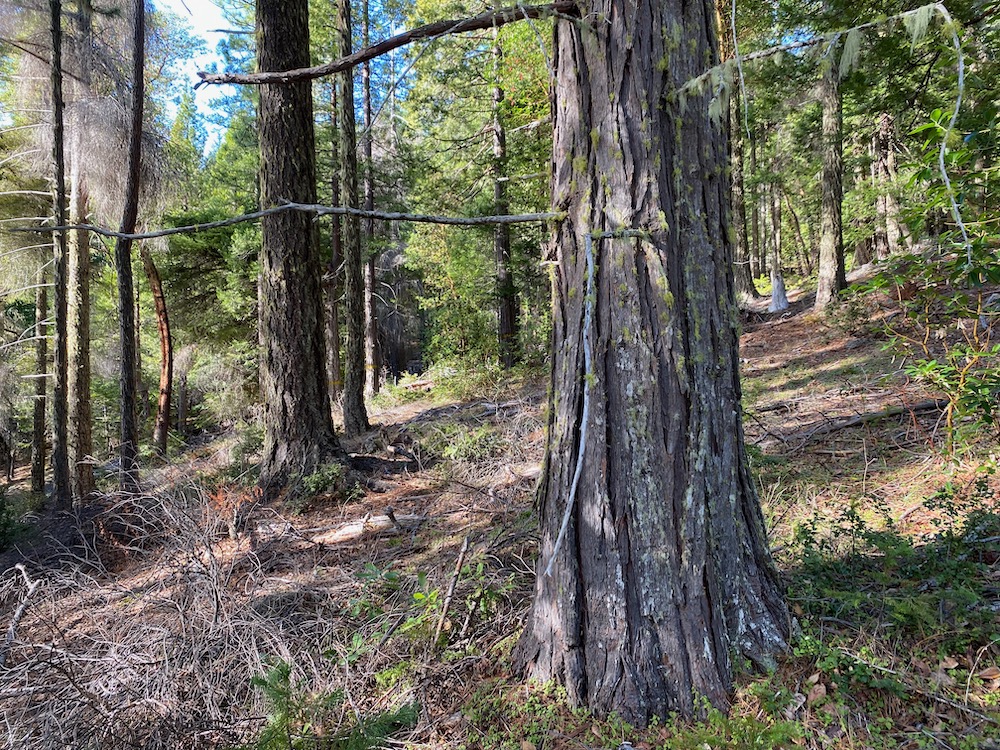
This unit is also located within the largest block of relatively connected old forest habitat in the Mungers LSR and is vital for the connectivity of old forest habitats in the Mungers and Powell Creek watersheds. It also contains significant late successional forest characteristics, and many of the area’s important habitat features would be removed if the proposed logging treatments occur.
Using the heavy handed “ecosystem resilience-open” prescriptions, the BLM is proposing significant canopy reduction, converting this relatively closed forest to a mere scattering of trees. Canopy cover could be reduced to as low as 30% and many dominant, old trees over 30” diameter would be removed. Such activity provides no benefit to the Mungers LSR, and instead will damage and degrade the old forest values this area was designated to protect.
Units 25-1C, 25-1D, 25-1E, 25-1F and 25-1G
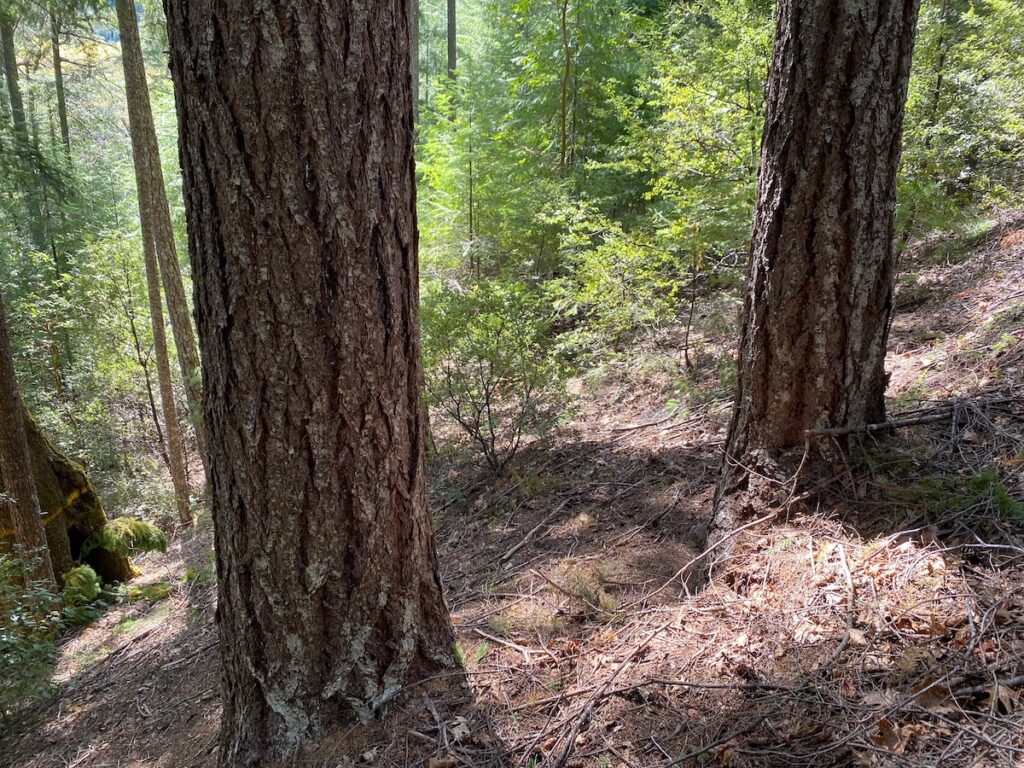
Unit 25-1 is a massive sprawling complex of commercial logging units, spread across the Mungers Creek watershed. Each sub-unit contains slightly different stand conditions and management histories. Some sub-units contain more large, old trees, and others contain more dense stands reproducing after previous logging operations. Some are located high on the ridgeline, on relatively exposed south-facing slopes, while others are located deep in the North Fork Mungers Creek canyon, adjacent to nesting, roosting and foraging habitat for the northern spotted owl.
Most of these units are mature and mid-successional stands with scattered old, dominant trees. They include forest of Douglas fir, sugar pine, ponderosa pine, the occasional incense cedar, wide branching live oak and beautiful madrone. The prescriptions in the Penn Butte Timber Sale throughout this area are among the most intensive in the entire timber sale area and include both large tree removal and group selection logging.

Group selection logging is a form of staggered clearcut forestry that would remove whole groves of mature, dominant trees. The goal is to create openings and dense young stands of regeneration. According to BLM analysis these treatments will increase fire risks, future fire intensity and resistance to control. Contrary to the rhetoric surrounding the IVM Project and the Penn Butte Timber Sale, these treatments will increase fire risks, reduce habitat quality, and degrade old forests habitats, while sacrificing our LSR forests to the timber industry.
Unit 25-2

Unit 25-2 contains mature to mid-successional stands dominated by Douglas fir and white fir, with scattered populations of large, old sugar pine and Douglas fir. In an effort to create very open stand conditions under the “Ecosystem Resilience-Open” prescription, a number of large, old, open grown trees are targeted for removal.
Additionally, the more closed, north-facing slopes would be dramatically opened through group selection logging and commercial thinning prescriptions, converting currently mid-successional, closed canopy stands into disturbed, open canopied stands that will soon fill in with highly flammable young vegetation.
Unit 25-3
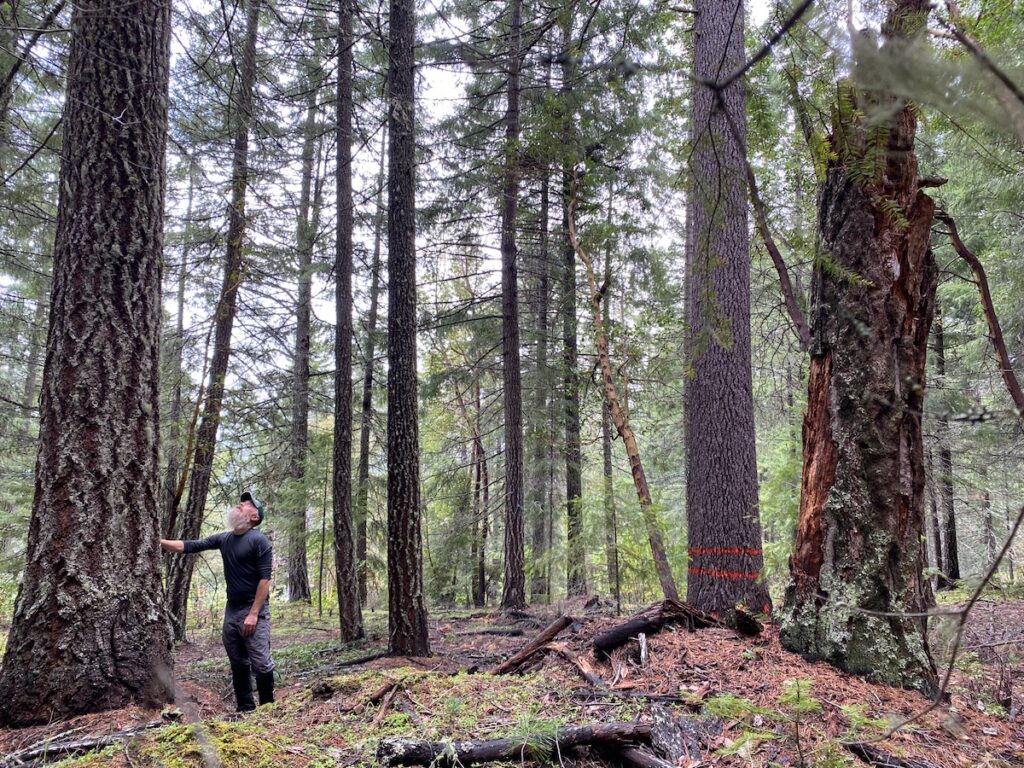
Unit 25-3 contains closed canopy stands of mature and mid-successional forest. These stands contain mostly Douglas fir and white fir between 24” and 40” in diameter, with scattered old-growth sugar pine and Douglas fir trees over 5 feet thick.
The south-facing slopes above road 38-6-25.5 drain into the North Fork Mungers Creek and contain closed canopy, but relatively open spaced stands. In these areas, canopy shade is suppressing understory fuel development and has created an equilibrium where overstory growth dramatically minimizes young, shrubby in-growth and conifer regeneration. Dominated by large trees, the stand is naturally fire resistant, was previously treated for small diameter fuels and is in the process of developing late successional forest conditions, heterogeneity, large diameter snag habitat and coarse downed wood.
The north slope of the unit is more productive, but was also historically more heavily logged. It also naturally contains a higher percentage of white fir than surrounding habitats, due to the protection and microclimate conditions associated with less solar exposure. Currently, old-growth groupings, groves and scattered individual sugar pine, ponderosa pine and Douglas fir trees grow above a more uniform layer of mid-successional forest and pole stands. These mid-successional cohorts have regenerated after previous BLM logging projects and are the most dense where previous canopy removal occurred.
The logging prescriptions proposed for unit 25-3 have been identified as “near term” treatments intended to maintain northern spotted owl habitat and 60% canopy cover. The agency is implementing this prescription with a slightly altered form of group selection logging, where, in theory, all trees up to 36” for Douglas fir and pine species and 40” for white fir would be removed within a 60’ radius of trees marked for retention. Trees marked for retention and radial tree removal have been identified on site with double red bands of paint and are widely scattered throughout the unit.

Currently, the BLM claims this unit has been fully marked, but trees both within the 60’ radius and over the stated diameter limit are not marked for retention. This includes trees up to 45” diameter with significant old-growth characteristics.
At a recent BLM field trip, the agency identified the area as a “prescription by designation” unit. This means that the loggers themselves will determine which trees are removed within the currently completely undefined 60′ radius from marked leave trees. Apparently, the BLM believes the loggers will measure the 60′ radius accurately, judiciously measure each individual trees diameter, and determine which trees will be removed with no bias, no self interest and no commercial value in mind.
When the public questioned the BLM on the recent field trip, why the BLM could not just mark all “reserve” trees beyond the stated diameter limit and identify the 60′ radius on the ground, BLM silvicultural staff told us that they did not want to take the time to mark the trees for retention and that the paint they used was prohibitively expensive. Apparently, according to BLM silvicultural staff, large old trees in LSR forest are not worth the time it takes or the aesthetically unpleasing paint necessary to “reserve” them from timber harvest. Concerned residents and the public would disagree.
In some places these radial group selection cuts appear to be specifically designed to target significant concentrations of large trees for removal within 60’ of a massive old pine tree. This includes stands where an old-growth sugar pine would be cleared out to 60’, allowing dozens of large Douglas fir and ponderosa pine trees between 20” and 36” (or more) to be removed. In other locations, smaller Douglas fir trees have been marked for retention, allowing a dozen or more trees of similar or even greater size to be removed in the 60’ radial group selection cut.
We have significant concerns regarding the size of trees targeted for removal in this unit, the impact this removal will have on microclimate and stand conditions following commercial logging operations, and the economically motivated tree removal throughout the Late Mungers Project Area and Mungers LSR. The removal of large old trees in this unit will dry out forest stands and trigger an aggressive understory shrub response, increasing fire risks and fuel loading with dense, young vegetation and logging slash. It will also degrade habitat conditions for the northern spotted owl by reducing the density of large, dominant trees, reducing canopy cover, impairing habitat complexity and disrupting snag and downed wood recruitment.
The current marking strategy will lead to the removal of large, old trees that exceed the upper diameter limit identified in the 2016 RMP and the IVM Project Decision Record. We cannot support, and the BLM cannot justify, allowing the logging company themselves to interpret and implement BLM logging prescriptions on the ground.
We also believe that removing white fir trees up to 40” in diameter in LSR forest is damaging to the values intended for protection in the Mungers LSR and cannot be justified, especially in stands like 25-3, where the north-facing slope recruits and sustains white fir, as a natural component of the forest community. Unit 25-3, the Late Mungers Project and the entire IVM Project should be canceled to protect public involvement, old forest values, and northern spotted owl habitats.
Unit 30-2
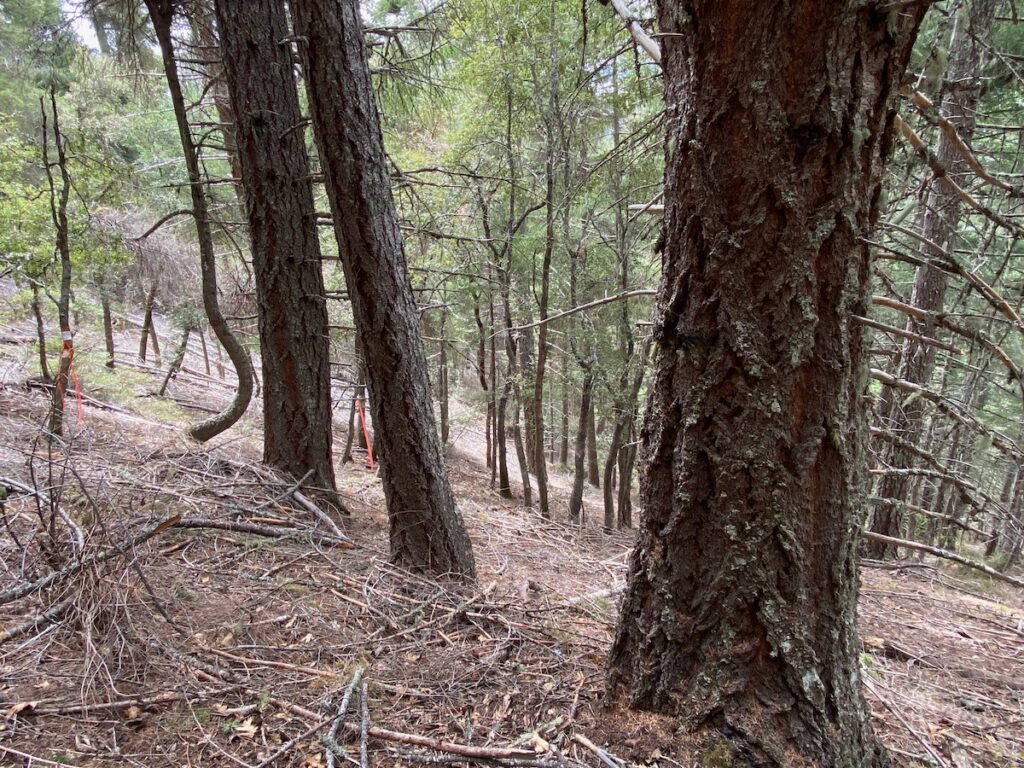
The Mungers LSR was designated specifically to maintain connectivity between old forest habitats and northern spotted owl populations in the Applegate and Illinois River watersheds. In the upper Mungers and Powell Creek watershed connectivity between old forests is relatively high, and some of the most intact forest habitats remaining in the Mungers LSR can be found.
Unit 30-2 contains two separate, but nearby stands at the headwaters of North Fork Mungers Creek. These uncut, mid-successional forests contain a scattering of large, old-growth trees directly adjacent to one of the largest blocks of northern spotted owl nesting habitat in the area. The forest in unit 30-2 provides dispersal habitat between watersheds and plays a very important role in the connectivity between old forest habitats in the Mungers LSR.
The northern portion of unit 30-2 contains largely mid successional Douglas fir groves between 18” and 40” diameter. The canopy of these large overstory trees pierce through a dense layer of multi-stemmed live oak that dominates the upper portions of the slope. Growing near the ridgeline and extending deep into the interior of unit 30-2, these live oak stands and the mid-successional Douglas fir groves scattered within them, have clearly regenerated from previous wildfires of relatively high severity. The now maturing groves of Douglas fir found within this unit, break up the live oak woodland, providing important structural diversity and high levels of fire resistance.
Douglas fir trees up to 35” diameter have been identified for removal and whole groves near the ridgeline are proposed for group selection logging, which proposed removing groupings of trees between 24” and 35” in diameter and up to two acres in size.
Logging this unit would also require new road construction, built across a previously unimpacted ridgeline. The development of this logging road will impact forest soils, increase the potential for noxious weed spread, facilitate illegal OHV use, damage existing native plant communities, and require the removal of many trees and forest canopy. This additional tree removal will increase the effect of stand drying, solar exposure and accelerated windspeeds. These influences will in turn desiccate fuels, alter microclimate conditions and regenerate dense woody vegetation, creating potentially more explosive fire spread and higher severity fire effects.
The southern section of unit 30-2 also clearly regenerated from the same historic wildfire event. Located lower on the slope, the area contains a few more legacy trees than the higher, drier northern section. The large old trees in this stand appear to have survived the historic, mostly stand replacing fire and now, provide continuity between the old and the new.

By surviving the previous wildfire, these trees became the foundation for both forest regeneration and future forest complexity. Widely scattered and relatively open grown, these large old trees grow amongst a mature, mostly even-aged cohort of Douglas fir between 20” and 30” diameter. Creating more closed stand conditions as it matures, this cohort is now suppressing understory growth, maintaining less flammable microclimate conditions, creating canopy shade, and higher levels of natural fire resistance. As this stand continues to mature, the development of favorable habitat conditions will increase and the mid-successional portions of the stand will transition towards more pronounced late successional habitat characteristics.
This southern portion of unit 30-2 proposes the removal of large, dominant trees over 30” in diameter, the creation of group selection openings and the fragmentation of mature forest groupings through large tree removal. Our monitoring found a relatively, open grown, old ponderosa pine tree identified for removal. This 33” diameter ponderosa pine tree, growing with an even larger sugar pine, is part of a dominant tree grouping that survived previous fires, droughts, and all forms of adversity. Unfortunately, after surviving everything mother nature has thrown at it for perhaps hundreds of years, the tree would be removed if the Penn Butte Timber Sale is approved.
Unit 35-1

Unit 35-1 is a moist and highly productive forest habitat with significant populations of coastal forest species such as salal, pacific yew, red huckleberry, scattered tanoak and Port Orford-cedar.
The stand was historically high graded in previous BLM logging treatments, removing the largest overstory trees in what was likely a very dense, closed canopy stand of Douglas fir and Port Orford cedar. Today, after the historic logging impacts, the lower portion of the stand, closer to Munger Creek, supports patchy groves of mature Port Orford cedar and Douglas fir between 18” and 40” diameter, while higher on the slope patches of Douglas fir and sugar pine grow among remnant old-growth hardwoods and patches of madrone.
The gnarled old-growth hardwoods include some of the most impressive golden chinquapin in the Applegate watershed and are remnants of the previous old-growth forest that survived in this location for hundreds of years before BLM logging operations. These old chinquapin trees over 40” in diameter, contain twisted old canopies, internal cavity habitat, complex branch structure and important old forest characteristics.
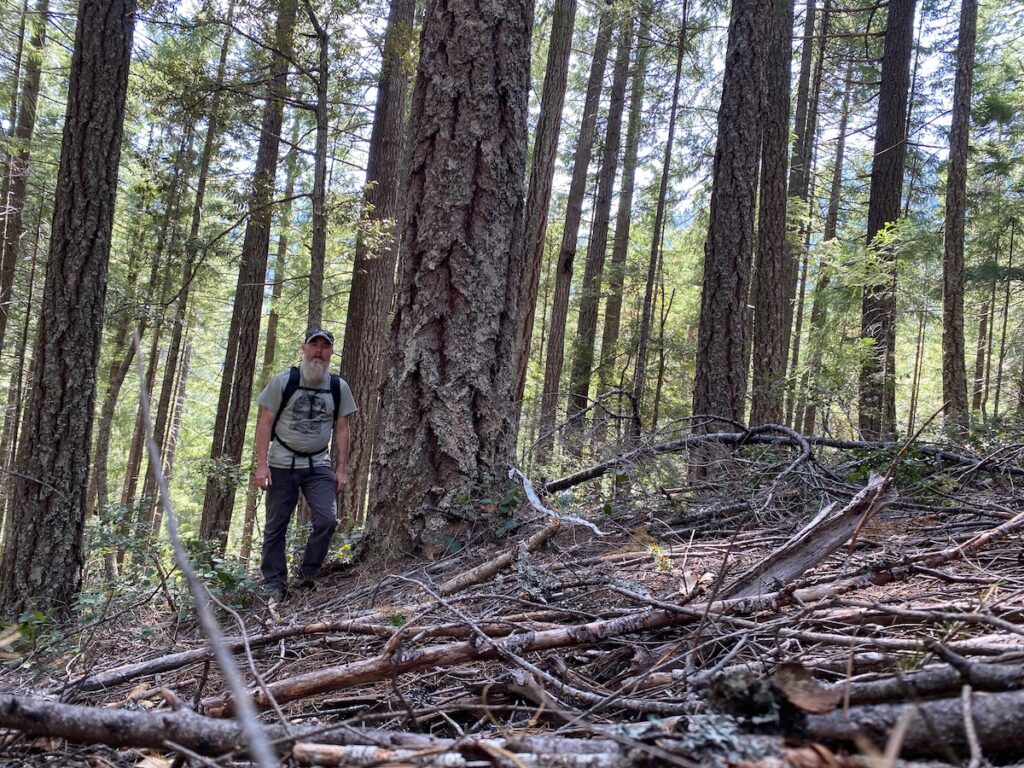
Although the agency claims the prescription for this unit emphasizes fuel reduction, it targets many large, fire resistant overstory trees and proposes the creation of group selection openings in moist, coastal influenced forests. These forests are more likely to act as fire refugia, than to burn at high severity. Growing low on the slope near Mungers Creek and a small tributary stream, the area is lush, moist, and highly productive, with forest associations more adapted to high rainfall and fog than frequent fire. The specific location of this unit, is perhaps one of the least likely areas to burn at high severity on this landscape and the most likely to develop high quality northern spotted owl habitat conditions if left undisturbed.
Located in high relative habitat suitability for the northern spotted owl, logging these stands will degrade northern spotted owl habitat, reduce forest complexity, degrade canopy conditions and reduce available denning habitat for the Pacific fisher, while also increasing fire risks and impacting scenic values.

Our monitoring efforts identified many Douglas fir trees between 30” and 33” in diameter identified for removal in unit 35-1. The removal of these large overstory trees along with the surrounding cohorts, will dramatically open canopy cover in moist, temperate forests that naturally support dense, closed canopy forest types. Unit 35-1 is not a dry, frequent fire forest and does not require logging treatments to maintain its health (no forest does). In fact, if anything it is still recovering from previous BLM logging treatments and must be allowed to mature to both reach its full stand development capacity and to maintain northern spotted owl habitat conditions in the Mungers LSR.
Conclusion:
Although stand conditions vary throughout the large footprint of commercial logging units proposed on Mungers and Powell Creek in the Penn Butte Timber Sale, we have found numerous common threads throughout the timber sale area. These commonalities pertain to the inappropriateness of logging treatments proposed in the Mungers LSR, the proposed removal of large, fire resistant trees, the dramatic reduction of canopy cover, the loss of forest complexity, and the degradation of northern spotted owl habitat. It also pertains to the consistent increase in fire risks that would occur if the industrial logging prescriptions in the Penn Butte Timber Sale were implemented.
Rather than restore or protect forests and communities from wildfire, the Penn Butte Timber Sale will threaten forests and communities with increased fire risks. According to the BLM’s own research the type of logging proposed tends to create brush and slash fuel types that are, “more volatile and susceptible to high rates of fire caused mortality. Stands could exhibit higher flame lengths, rates of spread, and fire intensity. Fires started within these stands could be difficult to initially attack and control,” and “the overall fire hazard would increase in these stands.”

Under the current climate scenario, we cannot afford to damage these old forests any further. They are vitally important for carbon storage, for climate mitigation, for connectivity, biodiversity, and watershed health. The Penn Butte Timber Sale, the Late Mungers Timber Sale and IVM Project should be withdrawn, LSR forests should be expanded as carbon reserves on federal lands, and the last old forests remaining on BLM lands should become part of the solution, rather than being managed to perpetuate the problem. Stop the IVM and Late Mungers Project!
